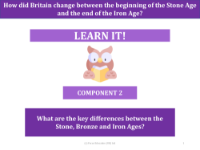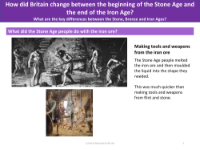How did people make their weapons in the Bronze age? - Writing task

History Resource Description
During the Bronze Age, people crafted their weapons using bronze, an alloy primarily consisting of copper and tin. The process began with the mining of these raw materials, which were then smelted in high-temperature furnaces to create liquid bronze. This molten metal was poured into stone or clay moulds to form the shape of various weapons, such as swords, daggers, and axes. Once the bronze cooled and solidified, the weapons were removed from the moulds and craftsmen would refine them by sharpening edges and adding decorative elements. The advent of bronze weaponry represented a significant advancement in technology, offering stronger and more durable tools and weapons than those made of stone.
Britain underwent profound changes from the beginning of the Stone Age to the end of the Iron Age. Initially, during the Stone Age, tools and weapons were made from flint and other stones through a process called knapping. As time progressed into the Bronze Age, metalworking techniques were introduced, leading to the development of bronze tools and weapons. By the Iron Age, iron had become the dominant material due to its abundance and superior strength, leading to the creation of even more effective tools and weaponry. This evolution of materials reflects the key differences between the Stone, Bronze, and Iron Ages, marking a transition from simple stone implements to more complex metalworking skills and resulting in significant societal and technological advancements.








